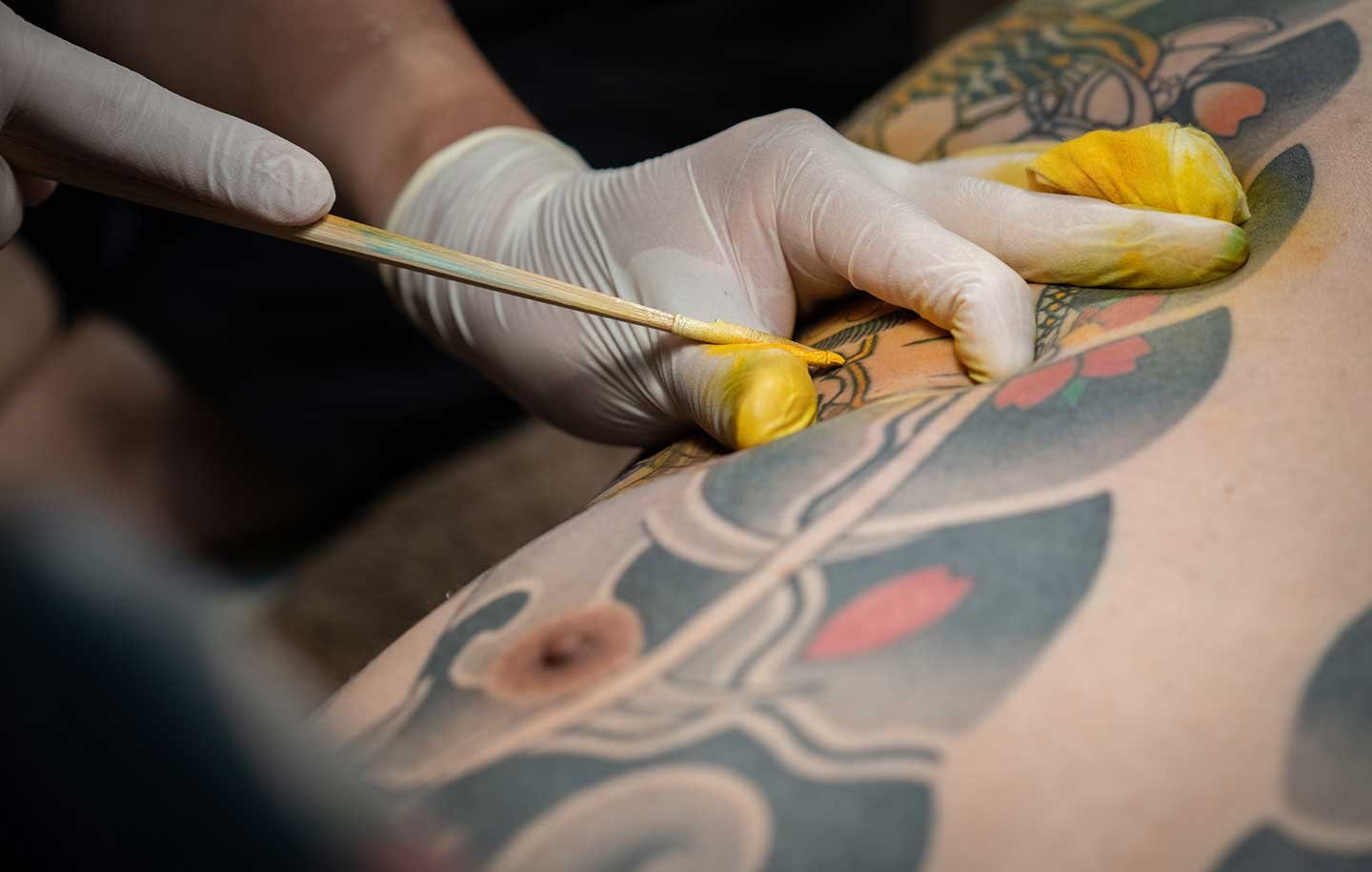

Irezumi is a traditional Japanese tattoo art that has been passed down for centuries. The term “irezumi” means “to ink”, which refers to the practice of inscribing designs on the skin using specialized inks. Unlike modern tattoos that use electric machines, the traditional technique in irezumi tattoo is known as the manual method called tebori. This technique is not just a method of tattooing, but encompasses cultural heritage, art and spiritual symbolism rich in meaning.
Before discussing the traditional technique, it is important to understand the historical background of irezumi. Irezumi has deep roots in Japanese history, with archaeological evidence showing the use of tattoos dating back to the Yayoi period (300 BC – 300 AD). At first, tattoos were used to mark social status or as criminal markers, but over time, irezumi evolved into a more intricate and meaning-rich art form.
In the Edo period (1603-1868), irezumi became increasingly popular, especially among the lower classes, manual laborers and artists. During this time, irezumi designs began to reflect Japanese mythology, folklore and natural elements that made it more than just a form of body decoration. However, tattoos also began to be associated with criminality, especially due to their association with the Yakuza, Japan’s organized crime group.

The tebori method is one of the most iconic techniques in irezumi making. Derived from the words “te” meaning hand and “bori” meaning carving, tebori literally means “carving by hand.” This technique is different from modern techniques that use electric tattoo machines. In tebori, the tool used is a kind of long needle mounted on a bamboo or metal handle, which is held by the tattoo artist (called horishi) and moved manually to ink into the skin.
Steps in Tebori Technique
Designing
Before the tattooing process begins, the horishi will work with the client to create a design. Designs in irezumi are generally very intricate and include traditional symbols such as dragons, koi, tigers, or cherry blossoms. The designs have deep symbolic meanings that are spiritual, cultural and personal.
Design Transfer to Leather
Once the design is finalized, the horishi will copy the design onto the skin using black ink. This becomes the basic guide for the rest of the tattooing process. At this point, the client can already see the big picture of the final result, although the process is far from complete.
The Tebori Process
At this stage, the horishi starts using a long needle attached to a handle. The needle is dipped in ink before being manually pressed into the skin. The hand movements used in tebori are very precise, with a consistent push-pull pattern. The speed, pressure, and angle of the needle are critical to producing sharp, consistent strokes.
Adding Color and Details
Once the basic lines are completed, the artist will start adding further details, such as shadows and colors. This technique is also done manually, where color ink is dipped into the needle and applied with the same hand movements. This process is time-consuming and requires tremendous patience and precision from both the artist and the client.
Healing and Maintenance
Once the session is complete, the client will receive instructions on how to care for the tattoo during the healing period. The healing process of irezumi can take several weeks, and the most important thing is to keep the tattooed area clean and moisturized to avoid infection.
Like any other traditional technique, tebori has advantages and disadvantages that set it apart from modern tattoo methods.
Advantages:
1. Color Depth
Tattoos made with the tebori technique often have greater depth of color than those made by machine. The manual process allows the ink to penetrate the skin in a more natural way, resulting in more vibrant and long-lasting colors.
2. Smooth Lines
The artist’s hand movements in tebori allow them to create very fine and detailed lines. This is especially important in intricate irezumi designs, where each line has a significant meaning and aesthetic role.
3. Traditional Experience
Many people choose tebori because they want to experience a traditional process that has historical and cultural value. Each tattoo made with tebori reflects the Japanese heritage that has existed for centuries.
Disadvantages:
1. Time-Consuming Process
Compared to tattoo machines, tebori is a much slower process. Since this method is done manually, a single design can take several long sessions, depending on the size and detail.
2. More Intense Pain
Many clients report that tebori is more painful than machine tattooing. This is because the needle is manually pressed into the skin, and the process is often deeper than modern methods.
3. Higher Cost
Due to the greater time and skill required, tebori tattoos are often more expensive than machine tattoos. Also, only a few artists have truly mastered this technique, which can also make it more exclusive and expensive.

Becoming a tebori artist is not easy. The learning process to master the technique can take years, during which aspiring artists must apprentice under the guidance of a more experienced horishi. During their apprenticeship, they learn how to use tools, understand the symbolism behind irezumi designs, and build close relationships with their clients.
Many tebori artists have nicknames that begin with “Hori” which means carving, followed by part of their name. This is a tradition in the Japanese tattoo world that shows their skill in manual carving.
While modern tattooing techniques continue to evolve, tebori has survived as a cherished art form. While fewer artists are practicing the technique, interest in traditional irezumi continues to grow both within and outside of Japan. Many tattoo art lovers are looking for an authentic experience and want to own a part of Japan’s rich cultural heritage.
Irezumi and the tebori technique are not just about etching ink into the skin, but also represent values, stories, and symbolism that have existed for centuries. Each stroke of ink in irezumi is part of a larger story, connecting the past and present and highlighting the incredible skills passed down from generation to generation.